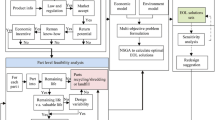Abstract
Remanufacturability assessment studies have been focused on analysing the feasibility whether a product can be remanufactured. However, not all components in a product are suitable for remanufacturing, e.g. some components may have to be disposed of due to wear and corrosion. This paper proposes a decision support tool to evaluate remanufacturability at the component level, to facilitate component end-of-life (EOL) strategy planning. The EOL strategies that maximize the expected savings under quality uncertainty are determined through comprehensive qualitative and quantitative analyses. A new approach is introduced to quantify and integrate environmental considerations into the decision-making process.
Similar content being viewed by others
References
Umeda Y, Takata S, Kimura F, Tomiyama T, Sutherland JW, Kara S, Herrmann C, Duflou R (2012) Toward integrated product and process life cycle planning—an environmental perspective. Ann CIRP 61(2):681–702
Du YB, Cao HJ, Liu F, Li CB, Chen X (2012) An integrated method for evaluating the remanufacturability of used machine tool. J Clean Prod 20(1):82–91
Vanessa MS, Gregory AK (2004) The value of remanufactured engines: life-cycle environmental and economic perspectives. J Ind Ecol 8(1–2):193–221
Johnson MR (2002) Evaluating remanufacturing and demanufacturing for extended producer responsibility and sustainable product management. PhD. Dissertation, University of Windsor
Ziout A, Azab A, Atwan M (2014) A holistic approach for decision on selection of end-of-life products recovery options. J Clean Prod 65:497–516
Lee HB, Cho NW, Hong YS (2010) A hierarchical end-of-life decision model for determining the economic levels of remanufacturing and disassembly under environmental regulations. J Clean Prod 18(13):1276–1283
Iakovou E, Moussiopoulos N, Xanthopoulos A, Achillas C, Michailidis N, Chatzipanagioti M, Kikis V (2009) A methodological framework for end-of-life management of electronic products. Resour Conserv Recycl 53(6):329–339
Chan JWK (2008) Product end-of-life options selection: grey relational analysis approach. Int J Prod Res 46(11):2889–2912
Staikos T, Rahimifard S (2007) A decision model for waste management in the footwear industry. Int J Prod Res 45(18–19):4403–4422
Bufardi A, Sakara D, Gheorghe R, Kiritsis D, Xirouchakis P (2003) Multiple criteria decision aid for selecting the best product end of life scenario. Int J Comput Integr Manuf 16(7–8):526–534
Goodall P, Rosamond E, Harding J (2014) A review of the state of the art in tools and techniques used to evaluate remanufacturing feasibility. J Clean Prod 81:1–15
King A, Barker S (2007) Using the Delphi Technique to establish a robust research agenda for remanufacturing. Proceedings of 14th CIRP conference on life cycle engineering, 219–24
Thorn BK, Rogerson P (2002) Take it back, IIE Solutions. Retrieved 1st Oct, 2014 from HighBeam Research: http://www.highbeam.com/doc/1G1-85407252.html
Ijomah W (2009) Addressing decision making for remanufacturing operations and design for-remanufacture. Int J Sustain Eng 2(2):91–102
Subramonian R, Donald H, Ratna BC (2010) Aftermarket remanufacturing strategic planning decision-making framework: theory and practice. J Clean Prod 18(16–17):1575–1586
Yuksel H (2010) Design of automobile engines for remanufacture with quality function deployment. Int J Sustain Eng 3(3):170–180
Lund R (1998) Remanufacturing: an American resource. Proceedings of the Fifth International Congress Environmentally Conscious Design and Manufacturing, 1–10
Amezquita T, Hammond R, Salazar M, Bras B (1995) Characterizing the remanufacturability of engineering systems. Proceedings ASME Advances in Design Automation Conference, 271–278
Lee SG, Lye SW, Khoo MK (2001) A multi-objective methodology for evaluating product end-of-life options and disassembly. Int J Adv Manuf Technol 18(2):148–156
Kongar E, Gupta SM (2006) Disassembly sequencing using genetic algorithm. Int J Adv Manuf Technol 30(5–6):497–506
Zhang XG, Zhang H, Jiang ZG, Wang YH (2013) A decision-making approach for end-of-life strategies selection of used parts. Int J Adv Manuf Technol. doi:10.1007/s00170-013-5234-0
Jun HB, Cusin M, Kiritsis D, Xirouchakis P (2007) A multi-objective evolutionary algorithm for EOL product recovery optimization: turbocharger case study. Int J Prod Res 45(18):4573–4594
Gonzalez B, Adenso-Diaz B (2005) A bill of materials-based approach for end-of life decision making in design for the environment. Int J Prod Res 43(10):2071–2099
Ghazalli Z, Murata A (2011) Development of an AHP-CBR evaluation system for remanufacturing: end-of-life selection strategy. Int J Sustain Eng 4(1):2–15
Seo KK, Park JH, Jang DS (2001) Optimal disassembly sequence using genetic algorithms considering economic and environmental aspects. Int J Adv Manuf Technol 18(5):371–380
Jin XN, Ni J, Koren Y (2011) Optimal control of reassembly with variable quality returns in a product remanufacturing system. Ann CIRP 60(1):25–28
Krikke HR, van Harten A, Schuur PC (1998) On a medium term product recovery and disposal strategy for durable assembly products. Int J Prod Res 36(1):111–140
Dong T, Zhang L, Tong R, Dong J (2006) A hierarchical approach to disassembly sequence planning for mechanical product. Int J Adv Manuf Technol 30(5):507–520
Ferguson M, Guide VD, Koca E, Souza GC (2009) The value of quality grading in remanufacturing. Prod Oper Manag 18(3):300–314
Smith VM, Keoleian AG (2003) The value of remanufactured engines: life cycle environmental and economic perspectives. J Ind Ecol 8(1–2):193–221
The automotive Parts Remanufacturer Association, retrieved on 1st Oct 2014, from http://www.apra.org
Kim HJ, Raichur V, Skerlos SJ (2008) Economic and environmental assessment of automotive remanufacturing: alternator case study. Proceedings of the 2008 International Manufacturing Science and Engineering Conference, 33–40
Schau EM, Traverso M, Finkbeiner M (2010) Life cycle approach to sustainability assessment: a case study of remanufactured alternators. J Remanufact 2(5):1–14
Atasu A, Guide VDR, Van Wassenhove LN (2010) So what if remanufacturing cannibalizes my new product sales? Calif Manag Rev 52(2):56–76
Author information
Authors and Affiliations
Corresponding author
Appendix
Appendix
Rights and permissions
About this article
Cite this article
Yang, S.S., Ong, S.K. & Nee, A.Y.C. EOL strategy planning for components of returned products. Int J Adv Manuf Technol 77, 991–1003 (2015). https://doi.org/10.1007/s00170-014-6505-0
Received:
Accepted:
Published:
Issue Date:
DOI: https://doi.org/10.1007/s00170-014-6505-0




